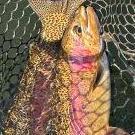The Meramec river system may be the most important river recreational area in Missouri due both to the high quality of these five major streams and their proximity to the largest metropolitan area in the state. The Meramec itself is as pretty as any stream in the Missouri Ozarks, furnishes a wide variety of fishing, and is the second longest undammed river within the Ozark region.
 The river has its beginnings in the area around Salem, Missouri, flowing north off the gently rolling divide that separates it from the headwaters of the Current River. In its upper reaches, the Meramec is a losing stream and is often dry, its flow sinking into the deep gravel beds along the channel. In fact, a tributary, Hutchins Creek, typically flows more water than the Meramec above it, and it is at the confluence of the two streams that the river first becomes fishable and intermittently even floatable. But the generally acknowledged “head of navigation” on the Meramec is the MDC Short Bend access near where Hwy. 19 crosses the river.
The river has its beginnings in the area around Salem, Missouri, flowing north off the gently rolling divide that separates it from the headwaters of the Current River. In its upper reaches, the Meramec is a losing stream and is often dry, its flow sinking into the deep gravel beds along the channel. In fact, a tributary, Hutchins Creek, typically flows more water than the Meramec above it, and it is at the confluence of the two streams that the river first becomes fishable and intermittently even floatable. But the generally acknowledged “head of navigation” on the Meramec is the MDC Short Bend access near where Hwy. 19 crosses the river.
From Short Bend, the Meramec flows for more than 195 miles in a generally northeastern direction to finally enter the Mississippi just south of St. Louis. Along the way it picks up water from many small, clear streams, numerous springs including Maramec Spring, the sixth largest spring in the Ozarks, and three major tributaries, the Big, the Bourbeuse, and the Huzzah (or four if you count the Huzzah and Courtois creeks as separate streams—they merge just a mile above where the Huzzah enters the Meramec). Many caves are found along the river, including Onondaga Cave and Meramec Caverns, which are justly world famous.
The middle reaches of the Meramec, and its two tributaries Huzzah and Courtois, are some of the most popular float streams in the Ozarks, and numerous canoe livery businesses and campgrounds dot their banks. In addition, thanks to the consistent volume of water the river receives from Maramec Spring and the Huzzah and Courtois, it is big enough for heavy jetboat use. If you're looking for solitude on the Meramec, you won't find it very easily in the warm weather months. But the beauty of the river and its good fishing can offset the sometimes crowded conditions.

The Meramec harbors nearly every game fish species found in the Ozarks. The smallmouth bass is the most sought after species, along with rainbow and brown trout in the area below Maramec Spring, but largemouth are also very common, non-native spotted bass are abundant in the lower half of the river, and goggle-eye (the northern rock bass, to be exact) are targeted by many of the local anglers. Crappie can be found in quiet water areas over much of the Meramec, and the sunfish family is further represented by bluegill, longear, and green sunfish. Walleye and sauger are found in the lower half of the river, white bass migrate up it from the Mississippi, channel and flathead catfish furnish excellent fishing over much of its course, freshwater drum are common, longnose gar are found in each large pool, and common carp furnish some fun fishing. The Meramec is also very popular with giggers, with abundant redhorse, hogsuckers, buffalo, and carpsuckers. In fact, because of the diversity of habitat in the Meramec from the cool, clear headwater stretches to the big, slow, murky lower reaches that connect with the Mississippi, the list of fish species found in the river numbers over a hundred.
That diversity is reflected in the characteristics of the different stream stretches. As each major tributary or spring enters the river, the character of the flow changes. Each section between tributaries is a different stream, but each has its own charm and beauty. Whatever you are looking for in a float stream, you can find it somewhere on the Meramec.



Recommended Comments
There are no comments to display.
Create an account or sign in to comment
You need to be a member in order to leave a comment
Create an account
Sign up for a new account in our community. It's easy!
Register a new accountSign in
Already have an account? Sign in here.
Sign In Now